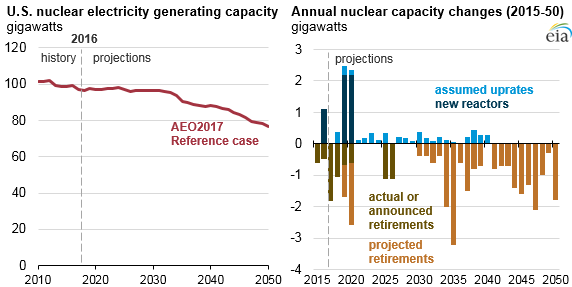This article was published in Scientific American’s former blog network and reflects the views of the author, not necessarily those of Scientific American
On Monday, the prestigious Proceedings of the National Academy of Sciences (PNAS)published a scathing critique of Stanford Professor Mark Jacobson’s analysis, which claims a full transition of all sectors of the U.S. energy system to wind, water, and solar power by 2050 is “technically and economically feasible with little downside.”
The article, authored by 21 leading energy researchers from institutions including U.C. Berkeley, Carnegie Mellon University, Columbia University, Lawrence Livermore National Laboratory, and Jacobson’s own Stanford University, found that Jacobson’s analysis “used invalid modeling tools, contained modeling errors, and made implausible and inadequately supported assumptions.” Thus, they conclude, Jacobson’s findings on the cost-effectiveness and feasibility of a full transition to wind, water, and solar “are not supported by adequate and realistic analysis and do not provide a reliable guide to whether and at what cost such a transition might be achieved. In contrast, the weight of the evidence suggests that a broad portfolio of energy options will help facilitate an affordable transition to a near-zero emission energy system.”
The controversy over Jacobson’s work has drawn significant attention from the popular media, because Jacobson’s work is seen as the justification for several state-level renewable energy plans and U.S. Senator Bernie Sanders’ 100 percent clean energy bill (Sanders and Jacobson announced the bill in a co-authored Guardian op-ed). Pieces published in the Washington Post and MIT Technology Review summarize the major shortcomings of Jacobson’s work identified in the PNAS paper. The most glaring of which is the assumption that U.S. hydroelectric dams could add turbines and transformers to produce 1,300 gigawatts of electricity instantaneously — equivalent to over 16 times the current U.S. hydroelectric capacity of 80 gigawatts. A previous study by the U.S. Department of Energy found the maximum capacity that could be added is just 12 gigawatts — leaving a 1,288 gigawatt deficit, or the equivalent of about 1000 large nuclear or coal power plants running at full power.
On supporting science journalism
If you're enjoying this article, consider supporting our award-winning journalism by subscribing. By purchasing a subscription you are helping to ensure the future of impactful stories about the discoveries and ideas shaping our world today.
For a complete rundown of the issues with Jacobson’s analysis, I suggest you read the full PNAS paper, which is clearly written and open access. Looking past the methodological minutia of Jacobson’s work and the PNAS rebuttal, I think there are two main takeaways from this controversy: (1) the research community is rigorously assessing itself in pursuit of a fully decarbonized energy system; and (2) achieving full decarbonization of the energy sector will be more challenging than Jacobson’s work implies, and downplaying those challenges does a disservice to decarbonization efforts.
Peer Review Worked
Among the energy research community, there have been growing doubts about the work of Jacobson and his colleagues, and its growing role in energy policy. On several occasions, researchers posed legitimate concerns about Jacobson’s work and were met with dismissive and flippant responses. Take this tweet from Jacobson in response to a polite question about thoughtful critiques of his work made by MIT energy researcher Jesse Jenkins on the Greentech Media Energy Gang podcast back in April:
I don't pay attention to non-experts, especially if they've worked at a nuclear advocacy org, BTI, where they must criticize other solutions https://t.co/tFBr98usBu
— Mark Z. Jacobson (@mzjacobson) April 14, 2017
In academic circles, responses like this one are unheard of and unacceptable. Research should be constantly reevaluated and critiqued. The appropriate response is to explain and justify your assumptions. If you can’t, you change your assumptions and move on. That’s how the scientific process works!
The tenor of Jacobson’s response is at least partly motivated by the fact that his work has become a rallying cry for American progressives, and in turn become a target of political attacks from conservatives. So it’s not all that surprising he would respond in a tone more akin to politics than academia.
The fact that 21 prominent energy and climate researchers could rise above the political fray and rigorously critique Jacobson’s methods and assumptions based on engineering and scientific principles shows that the peer-review process in the energy research community is alive and well. Considering the rise of misinformation and outright lies in the current political debate over climate change and decarbonization, we should all be happy that the energy research community is indeed holding itself to a high standard.
Decarbonization Is Hard. Pretending It’s Not Makes It Harder.
The limitations of Jacobson’s work identified in the PNAS paper indicate that a full transition to wind, water, and solar power is more costly and difficult than estimated. If we had the capability to generate 1,300 gigawatts of hydroelectric power on demand and deliver that power across the country instantaneously, then transition to a cost-effective 100 percent renewable energy system by 2050 might have little downside. But we don’t have that capability.
That doesn’t mean that decarbonization of the energy system is impossible. It just means that decarbonization won’t be as simple or inexpensive as claimed by Jacobson’s research and the advocacy group it spawned. Decarbonizing the electricity sector will likely require significant investments in new transmission and storage capacity, advanced nuclear technology, carbon capture and storage, building efficiency and flexibility, and the research, development, and demonstrations required to drive down technology costs and make it all work. An even more significant decarbonization challenge is the transportation sector, which still runs almost exclusively on dense liquid fossil fuels, and recently surpassed the electricity sector to become the largest source of U.S. energy-based carbon dioxide emissions.
Jacobson’s work understates the challenges of decarbonization using flawed methods and assumptions, and that makes the energy transition harder in a number of ways.
First, it fuels political attacks against all decarbonization efforts by undermining volumes of rigorous research (e.g. 1, 2) showing it is feasible to significantly decarbonize the electricity sector. Climate change and renewable energy skeptics now have a great talking point against any research that might be used to justify pro-renewable-energy policies — and it is Jacobson’s flawed research that delivered that talking point, not the 21 researchers that identified its flaws.
Second, downplaying the challenges of getting to 100 percent renewable energy falsely undermines the importance of investing in other non-renewable, low-carbon technologies such as nuclear power. Between now and 2050, the U.S. Energy Information Administration (EIA) projects about 20 gigawatts of nuclear capacity will retire. There have already been several imminent plant closures announced including Pennsylvania’s Three Mile Island and California’s Diablo Canyon plant. While building a new nuclear plant might be more expensive than building the equivalent renewable energy today, providing subsidies to existing plants can be an inexpensive way to reduce carbon emissions. For example, a study of New York’s decarbonization plans found that providing subsidies required to keep existing nuclear plants open (in the form of zero-emissions credits) would save consumers about $1 billion a year versus replacing the plants with new renewable energy capacity.

The U.S. Energy Information Administration (EIA) projects approximately 20 percent of U.S. nuclear capacity will be phased out by 2050. Credit: EIA
Finally, claiming that existing technologies alone are enough to technically and economically achieve full decarbonization “with little downside” downplays the urgent need for increased energy research and development to reduce the barriers to a decarbonized world. There is an urgent need for innovation across technologies — from advanced solar panels to advanced nuclear and carbon capture — to make decarbonization not only feasible but appealing. In this era of plummeting government support for energy research, we can’t afford to downplay the urgent need for significant and continued energy research and development.
What’s Next
It’s not clear what the impact on energy policy and politics will be once the dust finally settles in the wake of the controversy over Jacobson’s work. I hope that Jacobson and his colleagues will continue their work with a little more humility about their methods, assumptions, and conclusions. I also hope that the larger takeaway from this controversy isn’t that decarbonization is impossible, but that a dogged and dedicated community of researchers exists that is committed to acknowledging and overcoming the challenges to global decarbonization — and self-correcting when necessary.
